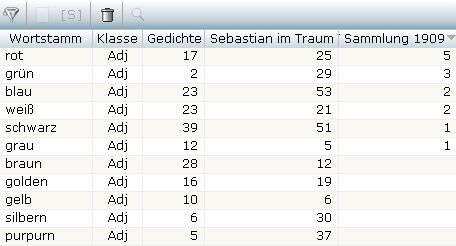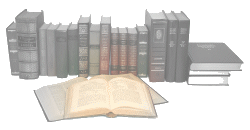3. Example: The Use of Adjectives of Colour in the Works of Trakl |
|

Examining this list, it is apparent that the adjectives "dunkel", "purpurn", "silbern", "still" and "grün" grow in importance in the author's later work ("Sebastian im Traum") whereas others such as "leise", "blau", "schwarz", appear to remain constant.
Using these results and support from a concordance program to examine other word and context lists, one might gain some insight into the "poet's workshop".
It is obvious to every reader that adjectives of colour play an important part in Trakl's work. This has been widely discussed in academic circles. Trakl's use of "blau", "rot" is reminiscent of parallels in the world of expressionism.
The following table shows the quantitative development in Trakl's use of adjectives of colour.

The proportion of adjectives of colour in the total number of adjectives:
| Adjektive insgesamt | Farbadjektive | % | |
| Sammlung 1909 | 471 | 14 | 2,97 |
| Gedichte | 902 | 181 | 20,07 |
| Sebastian im Traum | 1211 | 288 | 23,78 |
There is an obvious difference between the occurrence of adjectives of colour in the early work (Sammlung 1909) and later poems. In a letter to a friend he distanced himself from his early work and talked of his "heiß errungenen Manier" (struggle), of how he employed a technique using "vier Strophenzeilen, vier einzelne Bildteile zu einem einzigen Eindruck" (four lines, four separate parts of a picture are moulded into one single impression). This is known in literary criticism as (expressionist) "Reihenstil". An independent observer might conclude that it may have had less to do with the "heiß errungene Manier" and use of the so-called Reihenstil, than the change of vocabulary he used. (This does not only apply to the adjectives cited here, but to the vocabulary in total, which has been shown to be the case using the tools available in di-lemmata.)
In the later work "Sebastian im Traum", one could go as far as to claim that no noun could appear without being in danger of an adjective of colour accompanying it. So in the collection of poems in "Gedichte" and in "Sebastian im Traum", (the editions published with Trakl's approval), there is at least one adjective of colour in every poem. One could describe this as a constituent element of Trakl's later lyrics.
In order to illustrate the use of adjectives of colour further, a list can be drawn up showing the possible combinations of adjectives of colour and nouns.
1. Concrete Nouns
These nouns depend on perceptible reality and environment. The following distinctions have been made:
a) Objects that have been manufactured, e.g. das grüne Kleid (the green dress) or die rote Tischlampe (the red table lamp)
These objects can be combined with any adjective of colour (which may well stretch the imagination, but nonetheless remain within the bounds of possibility).
b) Natural Objects, e.g. der weiße Strand (the white beach).
Natural objects can be characterised by those colours in which they normally occur which limits or rather restricts the descriptive possibilities. Despite this, there are areas where these possibilities are expanded in a variety of ways and used in situations which one could describe as unrealistic combinations. These are generally referred to as metaphors. An example of the "impossible" combination of adjectives of colour with concrete nouns can be found in Paul Celan's famous "schwarze Milch" (black milk).
2. Abstract Nouns
a) In everyday speech, adjectives of colour can be found in combination with abstract nouns in stylised forms ("verblaßten Metaphern", faded metaphors) such as "graue Theorie" (unproven, dull theory), "blauer Montag" (Monday off work especially after a "rough" weekend). Quite often expressions such as these are predetermined by the symbolic value of the adjectives of colour, especially by "schwarz" and "weiß" (black and white), e.g. "weißer Sonntag" (White Sunday), "schwarze Gedanken" (evil / morbid thoughts). It can be noted that "schwarz" and "weiß", contain an inherent symbolism which can not easily be extracted from the cultural environment in which they are used. So for example "gelb" (yellow) symbolises hope in the USA. Colours can be used symbolically in everyday speech such as when politicians talk about a "grüne Zukunft" (environmentally green future).
b) Every combination of adjectives of colour with abstract nouns other than those in a) are categorised as "symbols". The term "symbol" has been used to avoid the use of "kühnen Metapher" ("bold metaphor") Every metaphor is based on analogy, but when that analogy is not readily identifiable, one can no longer use the term metaphor.
It is plain that this classification is not unambiguous as it is not always possible to differentiate between the concrete and abstract nouns as the "lexeme" (without context) may belong to both groups. An example of this is the "blaue Blume" of the Romantic era (often found in Trakl's work). This has long since developed into a symbol in which both parts point to their origins, but taken together must be considered as an abstract.
In order to remain within the limits of this introduction, the study has been confined to the distribution of the adjective "blau". This adjective of colour appears as an attribute in combination with the following nouns:
| 1. Concrete Nouns | |
| a) Manufactured | b) Natural |
|
Band Bilder Gewand (2) Glocken Kahn Kugeln Mantel (4) Panzer (Kriegers) Räumen Schleiern Tabernakel Zimmern |
Antlitz Augen (4) Bach Blume (10) Brauen (2) Falter Farben (2) Firne (3) Fluß (3) Früchte Gebirge Grunde Höhle (2) Kalvarienhügel Kristall Kuppeln (Himmelweiten) Lider (3) Luft (2) Quell (7) Schatten (2) Schleim Seen Tauben Teich (2) Tier (2) Wasser (5) Wild (6) Woge Wolke |
| 2. Abstract Nouns | |
| a) symbolic, conventional | b) Metaphor, Symbol |
|
Glanz Frühling |
Abend (6) Augenblick Gestalt (Menschen) Klage Kühle Lachen (2) Nacht Odem Orgelgeleier Seele (2) Stille (4) Stimme Ton |
Trakl combines 56 different lexemes with the adjective "blau", of which 19 (in bold script) appear to be used metaphorically, or perhaps phrased more cautiously, in an unconventional fashion. This simple example serves as a warning as to how one interprets the meaning of the adjective of colour "blau" in this context. A number of doubts arise.
A closer examination of two passages may help here:
a) O wie stille ein Gang den blauen Fluß hinab
Vergessenes sinnend, da im grünen Geäst
Die Drossel ein Fremdes in den Untergang rief.
b) Jener aber ging die steinernen Stufen des Mönchsbergs hinab,
Ein blaues Lächeln im Antlitz und seltsam verpuppt
In seine stillere Kindheit und starb;
It is not really adventurous to maintain that the "blaue Fluß" in example a) will be understood differently by the reader from the "blaue Lächeln" in b). Nothing is more conventional or natural (aside from any environmental issues) than a "blauer Fluß" (blue river). In fact, there is nothing exceptional here that would induce the reader to stop short, reflect deeply about it and express any form of astonishment or surprise. Something quite different can be expected when the reader comes across "blaue Lächeln". It is not so much that this is a most unusual phrasing (many expressions we take for granted nowadays were originally "unusual"). A modern "professional" reader of lyric poetry would not experience them as such, rather tend to expect new "unusual" phrasing and formulation which expand and enrich their view of the world. How then can one take the "blauen Lächeln" and discover a connection between "blau" and "Lächeln"? Goethes famous "graue Theorie" (dull theory) in opposition to the "grünen Baum des Lebens" (green tree of life - vibrant, active life) is instantly perceived as a metaphor because the analogies can easily be derived. Things are different in Trakl's "blauem Lächeln"; there is nothing analogous to be found in one's own area of experience or language. So, as the reader readily accepts the combination of "blau" and "Fluß" imperceptibly on the basis of his own experience and language, the reader views Trakl's "blaues Lächeln" as a contradiction that can not be resolved in his experience and language spectrum. The reader is vexed and irritated. On the premise that the author consciously chose his words (many would argue this point), the reader now needs to find an explanation or reason for this choice. This is the point, in our opinion, where every interpretation of aesthetic works begins and also the proliferation of the various readings and interpretations known as "Lesarten-Pluralismus". One result of the "irritation" experienced by coming across a "kühnen Metapher"or "Chiffre" in Trakl is the conclusion that the literary critic or expert finds the adjective "blau" (in our example) has a special place and value in Trakl's work.. This is a matter of conjecture and requires a more detailed analysis which can be achieved quickly and thoroughly using the reference basis available in di-lemmata.
From this initial study of the use of the adjective "blau", it is obvious that many other relevant questions can be posed. For example, which other attributes a noun may exhibit other than blue. The following list shows results using the noun "Schatten" (shadow / shade):

Once again, it is evident that aside from the conventional combinations such as "schwarze Schatten" (on the same semantic level as the "blaue Fluß" ), there are very unusual, almost erratic attributes to be found, such as "mondverschlungene" (moon-entwined), "gramvolle" (melancholy) Schatten. An extended analysis of nominal phrases in Trakl's work could be achieved on the basis of references gained here.
